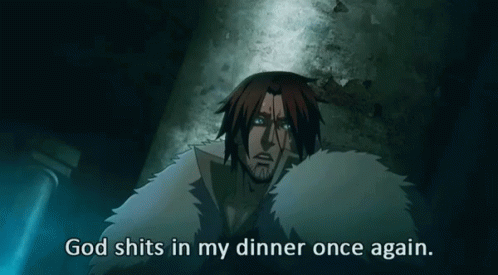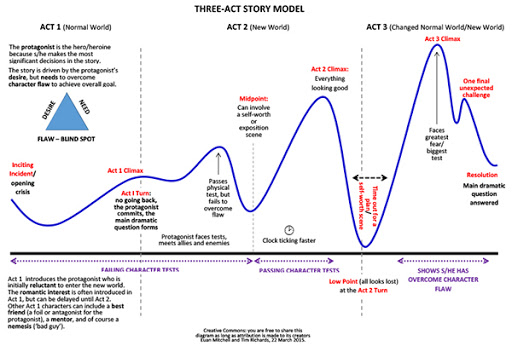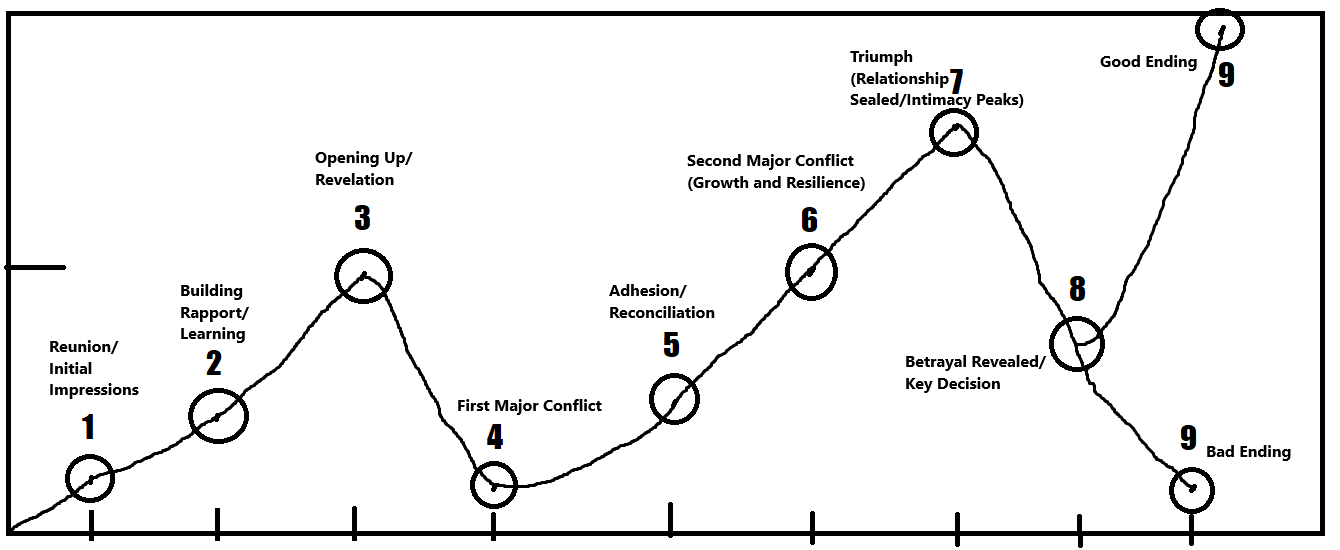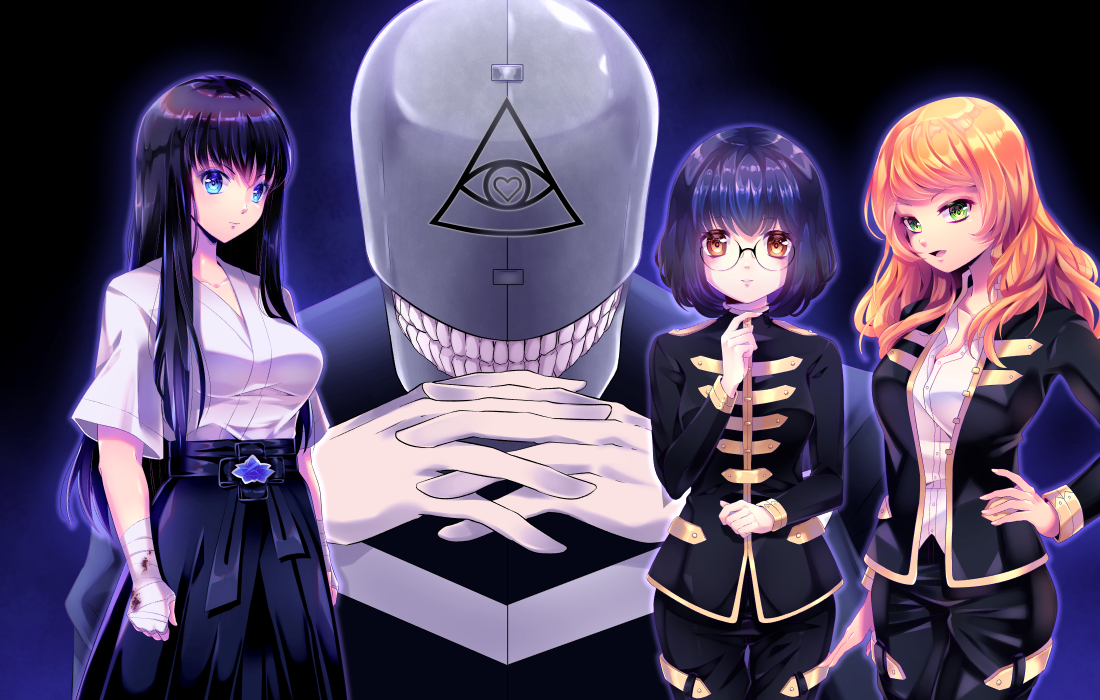3 Things I Learned While Creating the Demo, Part 2: Characters and Narrative
All right, we’re back here again talking about stuff I learned while making the demo for Black Heaven!
If you didn’t read Part 1, read it here.
This one is going to focus more on writing, characterization, and dialogue, rather than general game development. If the thesis of part one is that planning and organization are key to creating successful game, the thesis here is that characters and their relationships are at the heart of a romance story.
That may sound obvious, but it gets a lot more complicated. Here’s what I mean:
I was watching Castlevania for the first time recently, and it’s definitely my favorite new anime. The reason, one hundred percent, is the characters. Though Dracula overshadows everyone else by the sheer fact that he’s fucking Dracula, Sypha, Trevor, and Alucard are well-written characters that make you care about them.

That’s really interesting, because anime and manga usually aren’t the best place to find well-crafted characters. For every Paranoia Agent or Evangelion, there’s a dozen brain-dead, one-dimensional shows with stock characters coming out of every orifice.
When you’re not relying on tropes, your characters need to be complex and interesting to make their romance engaging to read. To do that in Black Heaven, I followed a couple guidelines:
- Create contradictions at the heart of each character.
- Use several internal motivations.
- Create a dramatic structure for romance relationships.
Complex characters are based on contradictions.
This is a writing trick I picked up in college, but I’m still exploring all the implications years later. The general idea, as explained by Alice LaPlante, is that people’s personalities are almost always built on contradictions, and most engaging, interesting characters are, too.
If you want to read a full run-down on how to implement this when designing characters, you can read my analysis of Mass Effect 2 here.
For Black Heaven, contradictions became the blueprint for each of the main characters, including the player character. Instead of falling back on well-known anime archetypes, like the tsunedere or dandere, I tried to build characters based around common contradictions:
- Ru is shy and retiring in public, but wild and chaotic in private.
- Izagi seems stoic and disciplined, but fiercely driven by her emotions.
- Leathe revels in being a social butterfly, but has few close friends.
These contradictions create endless material for creating engaging scenes and character moments, since each character comes built with a source of tension: does the character embrace one aspect of their personality, or another?
Use several internal motivations.
This one still gives me trouble. I don’t remember who said it, but some author said that every character should have at least six reasons for doing anything significant in a story. That “significant thing” could be anything from choosing to open up to someone to shouting someone down to killing themselves.
It’s difficult to do because our concept of “character motivation” is often simple, like a cause-and-effect chain: W is afraid of X because of Y, so they do Z. But a lot of the time, our decision-making process in real life is much more complicated than that—it ends up being a combination of conscious and unconscious thoughts, habits, our current emotional state, and other stuff.
Here’s an example of a situation I came across in Black Heaven:
Izagi, a talented martial artist, is naturally individualistic, driven, and competitive. However, as a senior student, she’s saddled with the PC as an in-class instructor for their martial arts class. After the PC fails their exercise for the final time, Izagi tries to palm off the PC on someone else.
- Reason 1: Izagi’s personality (individualistic, competitive) makes it hard for her to empathize with the PC.
- Reason 2: Izagi is concerned that she’s falling behind the other senior students.
- Reason 3: Izagi has a subtle kind of arrogance that assures her that other people don’t share her idealism and work ethic, and the PC seems to fit this narrative.
- Reason 4: Izagi has a deep-seated internal narrative that tells her that other people will always let her down, and the PC seems to be doing that.
It’s hard to do this with every character decision, but it ends up being really rewarding for key moments in the story, where characters need to come into conflict with one another. These layers of reasons, ranging from conscious to unconscious, allow you, as a writer, to write arguments and dialogue realistically.
Create a dramatic structure for romance relationships.
One of the big things I learned while working on this project was how to use (and adapt) a traditional three-act structure. As a fiction writer, I was more familiar with the Freytag Triangle than the similar (but more detailed) three-act dramatic structure used in movies, TV shows, and plays.
Here’s the Freytag Triangle:
 ...and
...and
...and here's the three-act structure:

You can see that the bottom image is more of an emotional roller coaster ride, rather than a steadily building slope of tension. That’s useful for a long-form narrative, especially one in a story-rich genre like dating sims.
In addition to this three-part dramatic template, though, there’s another one I heard about from Dave Olson from the YouTube Channel “Folding Ideas.” It’s laid out in Gwen Hayes book “Romancing the Beat: Story Structure for Romance Novels,” and it includes these milestones:
- Meet Cute: The romance interest and the MC are in the same scene for the first time.
- No Way #1: The MC resolves that the romance interest is definitely not for them.
- Adhesion: Circumstances forces the MC and the romance interest together.
- Falling in Love: The MC is tempted by the romance interest and begins to break down their resolve.
- No Way #2: The MC reiterates their resolve not to fall in love with the romance interest.
This isn’t the full list of steps, but it’s an interesting take on how to plot a story by making a romantic relationship into the main conflict of a story.
After learning about all these things, I created by own story structure based on what I’d seen in visual novels like Katawa Shoujo and Doki Doki Literature Club:

One of the things great stories do, especially long-form ones, is create miniature story arcs within larger one, so that each big arc is a microcosm of the whole structure of the story, including rising tension, turning points, climaxes, and so on.
When it comes to romance narratives, the conflict, drama, and emotional payoff is wholly wrapped up in the interactions between characters, so nailing this structure is key to making the narrative feel like a story, rather than just a chain of interactions between characters.
Conclusion:
Writing a romance story isn’t like other genres, and my narrative and character decisions had to be based on that. If you’re writing a horror visual novel, almost none of this stuff applies—your focus might be on the main character’s relationship to the mysterious monster, or on a deep dive into their psyche.
Every story needs a uniting theme, however, and for Black Heaven, mine ended up being influenced a lot by Neon Genesis Evangelion. NGE is one of the most brutal, thorny, and complex explorations of love, and one of the reasons I like it so much is because its thesis, arguably, is that being loved by someone doesn’t redeem you. Love, like anything else, can be warped and twisted into something destructive if you go into it with the wrong pretenses.
The next piece will most likely be about character design, and what the process was like creating the characters with the game’s artist, KeikoKup.
Get Black Heaven: a Necromantic Dating Sim
Black Heaven: a Necromantic Dating Sim
Collect the ghosts of your former friends!
| Status | In development |
| Author | Old No-Eyes |
| Genre | Visual Novel |
| Tags | Dating Sim, Fantasy, Horror, Post-apocalyptic |
More posts
- "Black Heaven" Is Live on Steam!Oct 28, 2023
- The Game Is Finished and Fulfilling to Kickstarter Backers!Jun 25, 2023
- The Kickstarter Is 329% Funded, All Stretch Goals Unlocked and More!Jun 25, 2023
- The Kickstarter Has Passed 55% Funding!May 03, 2021
- The Kickstarter for "Black Heaven" is LIVE!Apr 30, 2021
- The Kickstarter for "Black Heaven" Launches Tomorrow!Apr 29, 2021
- Kickstarter Preview Page Is Live - Follow the Game!Mar 08, 2021
- The Fifth New Chapter Is Here + Kickstarter Update!Mar 01, 2021
- 300 Download Celebration: Behind the Scenes of "Black Heaven"!Feb 13, 2021

Leave a comment
Log in with itch.io to leave a comment.